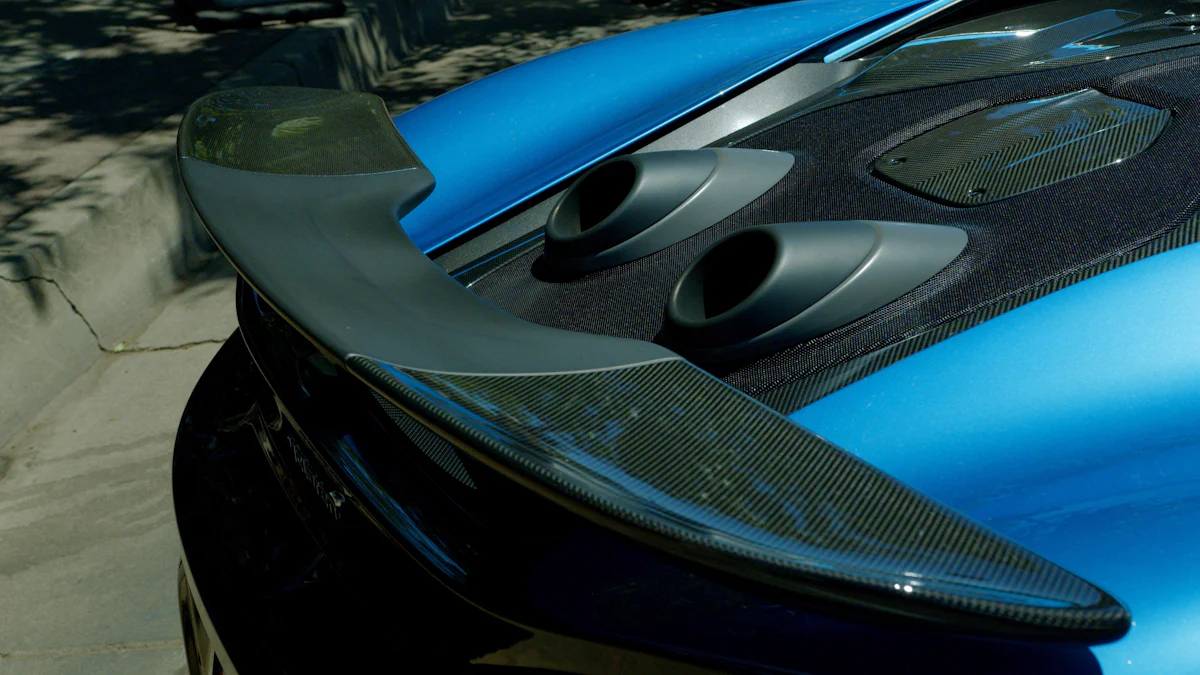Cómo mantener y proteger sus piezas de fibra de carbono

Maintaining carbon fiber parts is essential to ensure their durability and performance. These parts, known for their strength and lightweight properties, can deteriorate if neglected. Dirt, UV exposure, and environmental factors can weaken their structure or fade their finish. Proper care helps you preserve their aesthetic appeal and structural integrity. Regular cleaning, protective coatings, and inspections prevent damage and extend their lifespan. By taking proactive steps, you safeguard your carbon fiber components, ensuring they remain reliable and visually striking for years.
Principales conclusiones
Regular cleaning with soft microfiber cloths and pH-neutral soaps is crucial to preserve the finish of carbon fiber parts.
Apply a ceramic coating or high-quality wax to protect against UV rays and enhance the shine of your carbon fiber components.
Conduct regular inspections to identify early signs of wear, such as cracks or delamination, to prevent costly repairs.
Use clear protective films on vulnerable areas to guard against scratches and impacts, ensuring long-term durability.
Promptly clean off road salt and chemicals to prevent corrosion and maintain the integrity of your carbon fiber parts.
Seek professional help for complex repairs, such as structural damage or extensive delamination, to ensure safety and quality.
Store your carbon fiber parts in temperature-controlled environments to avoid degradation from extreme weather conditions.
A Guide to Cleaning Carbon Fiber Cars

Proper cleaning and care are essential to preserve the appearance and durability of your carbon fiber automotive parts. By following the right techniques and using suitable tools, you can maintain their finish and ensure they remain in excellent condition.
Essential Tools and Materials
To clean carbon fiber parts effectively, you need the right tools and materials. Here’s what you should use:
Soft microfiber cloths and sponges: These prevent scratches and are gentle on the surface.
pH-neutral automotive soaps and waterless car wash sprays: Choose a neutral car wash soap with a pH value of 7. Avoid alkaline cleaning agents like dishwashing detergent, as they can harm the finish.
Avoid abrasive materials and harsh chemicals: Abrasive cleaners or rough brushes can damage the clear coat and weaken the surface.
Using these tools ensures safe and effective cleaning without compromising the integrity of your carbon fiber components.
Step-by-Step Cleaning Process
Follow this simple guide to clean your carbon fiber parts thoroughly:
Rinse off dirt and debris with water: Use clean water to remove loose dirt, dust, and debris. Be gentle to avoid scratching the surface.
Apply a gentle cleaning solution or waterless spray: If the parts are heavily soiled, use a mild automotive-specific cleaner diluted in water. Waterless car wash sprays are also a great option for quick cleaning.
Wipe and dry with a microfiber cloth to prevent water spots: After rinsing, dry the surface immediately with a soft microfiber cloth. This step prevents water spots and keeps the finish looking flawless.
Regular cleaning not only enhances the appearance of your carbon fiber parts but also protects them from long-term damage caused by dirt buildup.
Tips for Maintaining the Finish
To keep your carbon fiber parts looking their best, follow these maintenance tips:
Using a ceramic coating or wax for added protection: Apply a ceramic coating or high-quality wax to shield the surface from UV rays and environmental contaminants. This adds a protective layer and enhances the shine.
Regular polishing to enhance the appearance: Polish the surface periodically to restore its luster and remove minor imperfections. This step helps maintain the smooth and glossy finish.
By incorporating these practices into your routine, you can extend the lifespan of your carbon fiber automotive parts and keep them in pristine condition.
Protecting Carbon Fiber Parts from Damage

Protecting your carbon fiber parts from damage is essential to ensure their longevity and maintain their appearance. Environmental factors, physical impacts, and improper care can compromise the integrity of these components. By adopting effective strategies, you can safeguard your carbon fiber products and preserve their value.
Preventing UV and Environmental Damage
Exposure to UV rays and environmental elements can degrade carbon fiber surfaces over time. Taking proactive measures helps you avoid fading, oxidation, and other forms of damage.
Applying UV-resistant coatings or wax: Use a high-quality protective coating designed for carbon fiber surfaces. These coatings, such as ceramic or UV-resistant wax, create a barrier that shields the finish from harmful UV rays and environmental contaminants. Research shows that coatings like Eversorb CP1 enhance carbon fiber durability and maintain its glossy appearance.
Parking in shaded areas or using protective car covers: Minimize direct sunlight exposure by parking your vehicle in shaded spots. When shade isn’t available, use a protective car cover to block UV rays and protect the surface from dust and debris. This simple step reduces the risk of long-term damage caused by environmental elements.
By implementing these practices, you provide essential protection from environmental elements and extend the lifespan of your carbon fiber components.
Avoiding Scratches and Impacts
Scratches and impacts can compromise the structural integrity and appearance of carbon fiber automotive parts. Preventing physical damage requires careful handling and additional protective measures.
Installing clear protective films: Apply clear protective films to vulnerable areas, such as hoods, mirrors, and bumpers. These films act as an invisible shield, absorbing minor impacts and preventing scratches. They are especially useful for maintaining carbon fiber durability in high-traffic or rough environments.
Handling parts carefully to avoid contact with sharp objects: Exercise caution when working around carbon fiber products. Avoid placing tools or sharp objects near these surfaces. Mishandling can lead to chips or cracks, which may require costly repairs.
Taking these precautions ensures your carbon fiber composite materials remain free from unnecessary wear and tear.
Long-Term Protection Strategies
Long-term care plays a crucial role in maintaining carbon fiber components. Consistent attention to detail helps you prevent gradual degradation caused by environmental and chemical factors.
Cleaning off road salt and chemicals promptly: Road salt, grime, and chemicals can corrode the clear coat and weaken the underlying material. After exposure, rinse your carbon fiber parts thoroughly with clean water. Regular cleaning prevents buildup and preserves the finish.
Avoiding prolonged exposure to extreme temperatures: Extreme heat or cold can affect the polymeric matrix of carbon fiber composites. Whenever possible, store your vehicle or parts in temperature-controlled environments. This precaution reduces the risk of material degradation and ensures long-term performance.
By following these maintenance tips, you can effectively protect your carbon fiber automotive parts and maintain their strength and appearance for years to come.
Regular Inspections and Maintenance for Carbon Fiber Parts
Regular inspections play a vital role in ensuring the longevity and performance of your carbon fiber parts. By identifying potential issues early, you can prevent further deterioration and costly repairs. Neglecting this step often leads to damage that compromises both the appearance and structural integrity of your components.
Identifying Signs of Wear and Damage
Carbon fiber surfaces require close attention to detect early signs of wear. Regular checks help you spot problems before they escalate.
Checking for cracks, chips, or delamination
Examine your carbon fiber parts for visible cracks or chips. These imperfections often occur due to impacts or stress. Delamination, where layers of the material separate, is another common issue. Run your fingers gently over the surface to feel for uneven textures or raised areas. Early detection of these problems ensures timely intervention.
Inspecting the clear coat for signs of degradation
The clear coat protects the finish of your carbon fiber components. Over time, exposure to UV rays and environmental elements can cause it to degrade. Look for dull spots, discoloration, or peeling. A compromised clear coat not only affects the appearance but also leaves the underlying material vulnerable to damage.
“Prevention is better than cure.” Regular inspections help you address minor issues before they become major concerns.
Addressing Issues Early
Taking prompt action when you notice damage is essential to maintain the quality and durability of your carbon fiber products. Ignoring small problems can lead to more extensive damage over time.
Repairing minor damage with resin kits
For small cracks or chips, use a resin repair kit designed for carbon fiber surfaces. These kits allow you to fill in damaged areas and restore the smooth finish. Follow the instructions carefully to ensure proper application. Polishing the repaired area afterward helps blend it seamlessly with the rest of the surface.
Replacing severely damaged parts to prevent further issues
When damage is extensive, replacement becomes the best option. Severely cracked or delaminated parts can compromise the safety and performance of your vehicle. Replacing these components ensures that your carbon fiber products remain reliable and visually appealing.
By inspecting and addressing issues regularly, you protect your investment and extend the lifespan of your carbon fiber components. Consistent care not only preserves their functionality but also keeps them looking their best.
When to Seek Professional Help for Carbon Fiber Repairs
Carbon fiber repairs often require expertise and precision. While minor issues can sometimes be addressed at home, certain situations demand professional intervention. Knowing when to seek help ensures the safety, durability, and appearance of your carbon fiber parts.
Recognizing Complex Repairs
Some damages go beyond basic fixes and need specialized attention. Identifying these complex issues early can save you from further complications.
Structural damage or deep cracks
Deep cracks or structural damage compromise the integrity of carbon fiber components. These issues often result from significant impacts or stress. Attempting to repair such damage without proper knowledge can worsen the problem. Professionals possess the tools and expertise to restore the strength and functionality of the material.
Expert Insight: “Repairing carbon fiber is not a DIY project. It requires specialized knowledge and skills.” – Natural State Carbon Repair
Extensive delamination or resin failure
Delamination occurs when the layers of carbon fiber separate, leading to weakened performance. Resin failure, where the bonding material deteriorates, also poses a serious risk. These problems are not always visible to the naked eye. Professionals use advanced techniques to detect and address hidden damage effectively.
Expert Insight: “One of the biggest challenges in carbon fiber repair is identifying hidden damage that is not visible to the naked eye.” – StablWall
Choosing the Right Professional
Selecting the right expert ensures high-quality repairs and long-term reliability. A careful approach helps you find a specialist who meets your needs.
Researching specialists in carbon fiber repair
Look for professionals with proven experience in repairing carbon fiber parts. Check reviews, certifications, and portfolios to assess their expertise. Specialists often use advanced methods tailored to carbon fiber materials, ensuring precise and durable repairs.
Expert Advice: “If you’re unsure about how to repair or maintain a damaged carbon fiber part, don’t hesitate to seek help from a professional.” – Piyesa Hub
Ensuring the use of proper tools and techniques
Carbon fiber repairs demand specific tools and techniques. Professionals rely on equipment like vacuum bagging systems and specialized resins to achieve optimal results. Verify that the repair service uses industry-standard methods to maintain the quality and performance of your carbon fiber components.
Seeking professional help for complex repairs protects your investment and ensures the longevity of your carbon fiber parts. Trusting experts with the right skills and tools guarantees that your components remain safe, functional, and visually appealing.
Maintaining your carbon fiber parts is essential to ensure their longevity and performance. Regular cleaning, protection, and inspections help preserve their strength and appearance while preventing costly damage. By taking proactive steps, you can keep your carbon fiber components in excellent condition and extend their lifespan. For complex repairs, seeking professional help guarantees safety and quality, ensuring your investment remains worthwhile. Proper care unlocks the full potential of this exceptional material, allowing you to enjoy its benefits for years to come.
PREGUNTAS FRECUENTES
How often should you clean carbon fiber automotive parts?
You should clean carbon fiber automotive parts at least every two weeks. Regular cleaning prevents dirt buildup and protects the clear coat from damage. This routine ensures your parts maintain their sleek appearance and durability over time.
How can you protect a freshly polished carbon fiber surface?
To protect a freshly polished carbon fiber surface, you can choose one of three effective methods:
Apply a ceramic coating for long-lasting protection.
Use a high-quality wax to enhance shine and shield against contaminants.
Wrap the surface with a paint protection film to guard against scratches and impacts.
These options help preserve the finish and keep your carbon fiber components looking pristine.
What is recommended for caring for carbon fiber pieces?
Using specialized products like AutoTecknic’s spray-on polish is highly recommended for maintaining carbon fiber pieces. This product enhances the surface’s shine while providing a protective layer. Incorporating such care into your routine ensures your carbon fiber car exterior remains lightweight and durable.
How should you care for carbon fiber components?
Caring for carbon fiber components is similar to maintaining painted surfaces. Wash them with a gentle cleanser, polish them periodically to restore their luster, and apply wax or sealant for added protection. These steps keep your carbon fiber car interior and exterior in excellent condition.
What is essential for maintaining the appearance and longevity of carbon fiber car parts?
Regular cleaning and maintenance are essential for preserving the appearance and longevity of carbon fiber car parts. Consistent care prevents damage, enhances durability, and ensures your vehicle retains its value.
How should you wash and dry carbon fiber parts?
When washing carbon fiber parts, use a gentle automotive soap or cleanser. Avoid harsh chemicals that could damage the clear coat. After washing, dry the parts immediately with a soft microfiber towel to prevent water spots and scratches. This method ensures a fully restored carbon fiber finish after every wash.
Can carbon fiber components withstand extreme weather conditions?
Carbon fiber components are lightweight and durable, but prolonged exposure to extreme temperatures can weaken their structure. To protect them, store your vehicle in a temperature-controlled environment or use protective covers when parked outdoors.
Are there customization options for carbon fiber car interiors?
Yes, carbon fiber car interiors offer various customization options. You can choose from different finishes, such as matte or glossy, and even select unique patterns to match your style. These options allow you to personalize your vehicle while maintaining its premium look.
What role does car detailing play in maintaining carbon fiber parts?
Car detailing plays a crucial role in maintaining carbon fiber parts. Professional detailing services often include polishing, waxing, and applying protective coatings. These treatments enhance the appearance and provide long-term protection for your carbon fiber components.
When should you seek professional help for carbon fiber repairs?
You should seek professional help when dealing with structural damage, deep cracks, or extensive delamination. Professionals have the expertise and tools to restore your carbon fiber components effectively. Trusting experts ensures your parts remain safe and functional.
